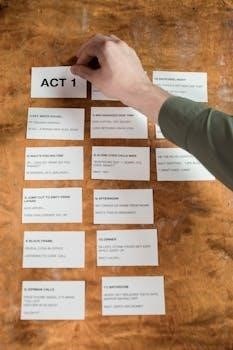Romeo and Juliet Screenplay⁚ An Overview
Romeo and Juliet screenplays offer various interpretations of Shakespeare’s iconic play․ These adaptations range from Baz Luhrmann’s modern, vibrant take to Franco Zeffirelli’s classic approach․
The screenplays adapt the original text, with varying degrees of modernization and emphasis on visual storytelling․ They highlight key themes like love, fate, and conflict․
Shakespeare’s Original Play
William Shakespeare’s Romeo and Juliet, a cornerstone of English literature, tells the tragic story of two young lovers from feuding families․ Set in Verona, the play explores themes of love, hate, fate, and societal conflict through poetic language and dramatic action․ The original text, divided into five acts, features iconic scenes like the balcony scene and the Capulet ball, where Romeo and Juliet first meet․
Shakespeare’s language, though beautiful, can be challenging for modern audiences․ Characters like Mercutio, Tybalt, and Friar Laurence contribute to the play’s rich tapestry of emotions and motivations․ The prologue foreshadows the tragic end, emphasizing the lovers’ destiny․ The play’s enduring appeal lies in its exploration of universal human experiences and its powerful depiction of youthful passion․
Adaptations and Interpretations
Romeo and Juliet has been adapted and interpreted countless times across various media, each offering a unique perspective on Shakespeare’s original play․ These adaptations range from stage productions to film, television, and even graphic novels, reflecting diverse cultural contexts and artistic visions․ Filmmakers often modernize the setting, language, or characterizations to resonate with contemporary audiences․
Interpretations can vary significantly, focusing on different aspects of the story, such as the intensity of young love, the destructiveness of social conflict, or the role of fate in human lives․ Some adaptations emphasize the violence and chaos of the feuding families, while others highlight the romantic and idealistic elements of the love story․ Each adaptation provides a fresh lens through which to examine the timeless themes of Romeo and Juliet․

Key Screenplay Adaptations
Several film adaptations of Romeo and Juliet stand out, each offering a distinct style and interpretation․ Baz Luhrmann’s 1996 film and Franco Zeffirelli’s 1968 film are two notable examples․
Baz Luhrmann’s 1996 Film⁚ A Modern Take
Baz Luhrmann’s 1996 film offers a bold, modern interpretation of Shakespeare’s classic․ The film transplants the story to Verona Beach, where the Capulets and Montagues are depicted as rival gangs․ This adaptation infuses the timeless tale with contemporary violence and a fast-paced energy․
The screenplay, co-written by Craig Pearce and Luhrmann, retains much of Shakespeare’s original dialogue while updating the setting and visual style․ Costumes feature stylish and vibrant clothing․ The use of guns instead of swords modernizes the conflict between the families․
The film’s success is demonstrated by awards like the Alfred Bauer Prize and the BAFTA for Best Adapted Screenplay․ Leonardo DiCaprio and Claire Danes portrayed the star-crossed lovers․ The screenplay captures the essence of youthful passion and tragedy․
Franco Zeffirelli’s 1968 Film⁚ A Classic Approach
Franco Zeffirelli’s 1968 film presents a more traditional interpretation of Romeo and Juliet․ The screenplay stays faithful to Shakespeare’s original language and setting․ It offers a visually stunning rendition of Renaissance Verona․ The film emphasizes the tragic love story with classic costumes and detailed sets․
Zeffirelli’s direction focuses on the emotional depth of the characters․ The actors use Shakespearean verse with precision, enhancing the play’s poetic essence․ This adaptation avoids modernizing the context․
The movie’s success is rooted in its adherence to the source material․ It features authentic costumes and classic interpretations of the characters․ The film received critical acclaim․ It captured the hearts of audiences worldwide․ The screenplay uses Shakespeare’s original text to portray the timeless story․

Analyzing Specific Screenplay Elements
Screenplays of Romeo and Juliet showcase unique elements, including the prologue․ Modern English translations, and character development are all essential parts․ Adaptations highlight themes of love, fate, and conflict in various styles․
The Prologue in Screenplays
The prologue in Romeo and Juliet screenplays serves as an essential element, setting the stage for the tragic love story․ It introduces the feuding families of the Montagues and Capulets, highlighting the animosity that permeates Verona․
Adaptations often utilize the prologue to establish the context and foreshadow the lovers’ doomed fate․ Baz Luhrmann’s 1996 film presents the prologue through a television news report, modernizing the language and setting․ This approach immediately immerses the audience in the contemporary setting of Verona Beach, where rival gangs replace the traditional families․
In contrast, Franco Zeffirelli’s 1968 film adopts a more classical approach, retaining Shakespeare’s original language and presenting the prologue as a spoken narration․ This version maintains the play’s traditional tone, emphasizing the themes of fate and inevitable tragedy․ The prologue’s function remains consistent across adaptations, providing crucial background information and hinting at the tragic events to come, thereby shaping the audience’s expectations․
Modern English Translations in Screenplays
Modern English translations in Romeo and Juliet screenplays aim to make Shakespeare’s language accessible to contemporary audiences․ These adaptations often balance the original text’s poetic beauty with modern understanding․ Some versions provide line-by-line translations, aiding comprehension of complex and archaic phrases spoken by characters like Romeo, Juliet, Mercutio, and Friar Laurence․
Screenplays sometimes integrate modern dialogue to clarify key plot points or character motivations․ The goal is to retain the essence of Shakespeare’s story while ensuring the audience can easily follow the narrative․ Baz Luhrmann’s film notably uses modernized language alongside Shakespearean verses, creating a unique blend․
These translations are crucial for engaging younger viewers and those unfamiliar with Elizabethan English․ Accessibility allows for a broader appreciation of the play’s themes, such as love, conflict, and fate․ By bridging the gap between the original text and contemporary understanding, modern English translations ensure that Romeo and Juliet remains relevant and impactful․
Character Development in Adaptations
Adaptations of Romeo and Juliet often explore character development through various cinematic techniques․ Screenplays may add scenes or dialogue to provide deeper insights into the motivations and emotions of characters like Romeo, Juliet, Mercutio, and Tybalt․ These additions can enhance the audience’s understanding of their actions and relationships․
Baz Luhrmann’s adaptation, for instance, emphasizes the youthful impulsiveness of Romeo and Juliet by portraying them as teenagers in a modern setting․ This choice highlights their vulnerability and intensifies the tragedy of their fate․
Furthermore, screenplays might reinterpret minor characters to amplify thematic elements․ The Nurse, for example, could be portrayed with more comedic or tragic depth, depending on the adaptation’s overall tone․ By carefully shaping character arcs, screenwriters can bring new layers to Shakespeare’s original work, offering fresh perspectives on timeless themes of love, conflict, and societal pressures․
Ultimately, character development in adaptations serves to make the story more relatable and emotionally resonant for contemporary audiences․

Themes and Motifs in Screenplays
Screenplays of Romeo and Juliet emphasize core themes like love, fate, and conflict through visual and narrative techniques․ Adaptations often amplify motifs like light and darkness, reflecting the play’s emotional intensity;
Love and Fate
In Romeo and Juliet screenplays, the theme of love is portrayed as an intense, all-consuming force that defies familial and societal barriers․ The star-crossed lovers’ instant connection highlights love’s impulsive nature, leading them to make drastic decisions․ Their secret marriage and unwavering devotion underscore love’s transformative power amidst hatred and violence․
The concept of fate looms large, influencing the characters’ actions and shaping their tragic destiny․ The prologue explicitly labels Romeo and Juliet as “star-crossed,” suggesting their doom is predetermined․ Chance encounters, miscommunications, and impulsive choices, all contribute to the unfolding tragedy, reinforcing the idea that fate is an inescapable force․ Adaptations often visually emphasize these elements, using lighting, symbolism, and dramatic irony to heighten the sense of impending doom and the lovers’ helplessness against a predetermined course․ The intertwining of love and fate emphasizes the play’s exploration of free will versus destiny․
Violence and Conflict
Violence and conflict are pervasive themes in Romeo and Juliet screenplays, reflecting the deep-seated animosity between the Montagues and Capulets․ The opening scenes often depict street brawls, showcasing the constant tension and the ever-present threat of physical aggression․ Tybalt’s aggression and Mercutio’s fiery temper contribute to the escalating violence, culminating in their deaths and Romeo‘s banishment․
The screenplays visually represent the violence, using fight choreography, camera angles, and editing techniques to create a sense of chaos and brutality․ The conflict extends beyond physical altercations, encompassing verbal clashes and familial disputes․ The pressure from their families intensifies the lovers’ despair, driving them to desperate measures․ The contrast between the lovers’ pure love and the surrounding violence underscores the destructive consequences of hatred and the senseless loss of young lives․ Adaptations may also explore the social and political contexts that fuel the conflict․

Availability of Romeo and Juliet Screenplays
Accessing Romeo and Juliet screenplays is possible through online PDF versions and published books․ These resources provide valuable insights into adaptations and interpretations of Shakespeare’s work, including original stage plays․
Finding PDF Versions Online
Locating PDF versions of Romeo and Juliet screenplays online is straightforward, offering immediate access to various adaptations․ Websites dedicated to screenplays often host numerous versions, including Baz Luhrmann’s modern interpretation and Franco Zeffirelli’s classic approach․ These digital resources provide valuable opportunities to study the scriptwriting techniques employed in different cinematic adaptations․
Many sites offer the complete original play alongside modern English translations, facilitating a deeper understanding of Shakespeare’s complex language․ Educational platforms and online libraries frequently provide free downloads of adapted scripts, making them accessible for educational and performance purposes․ Researchers and students can easily compare different screenplay versions to analyze how various directors and writers have interpreted the source material․
However, users should verify the legitimacy of the source to ensure they are accessing complete and accurate versions․ Copyright restrictions may apply, so it’s crucial to use these resources responsibly, primarily for educational or personal study․
Published Screenplay Books
Published screenplay books offer a tangible and curated way to access Romeo and Juliet adaptations․ These books often include the complete screenplay, along with additional content such as introductions, annotations, and behind-the-scenes insights from the filmmakers․ Purchasing a published screenplay ensures a high-quality, verified version of the script, free from the potential inaccuracies found in online downloads․
Many editions feature critical essays that analyze the adaptation’s choices, character development, and thematic interpretations․ These books serve as valuable resources for students, scholars, and film enthusiasts seeking a deeper understanding of the cinematic translation of Shakespeare’s play․ Screenplay books are readily available from major booksellers and online retailers, offering a convenient and reliable way to study the art of adaptation․
Some editions may also include storyboards, costume designs, and interviews with the cast and crew, providing a comprehensive look at the production process․ Owning a published screenplay book offers a collector’s item and study tool for those passionate about film and literature․




